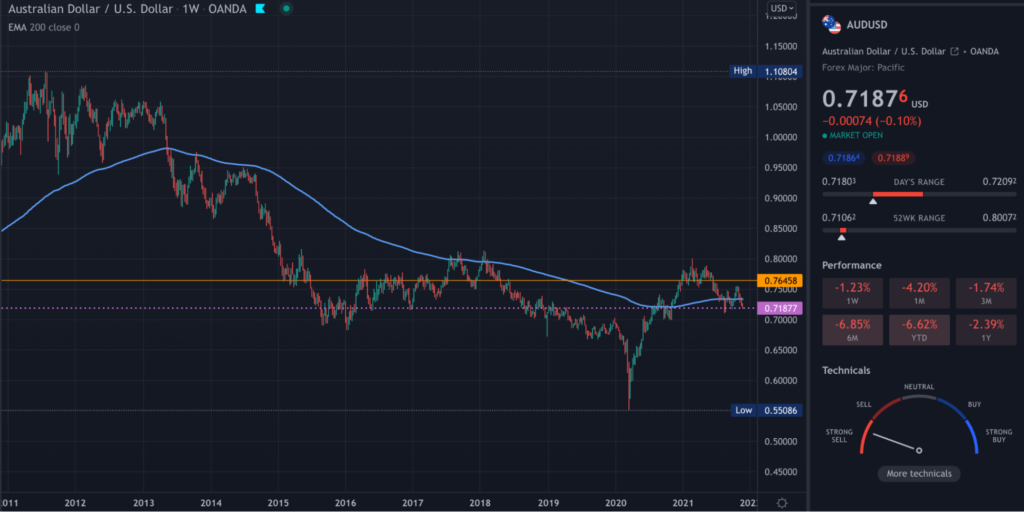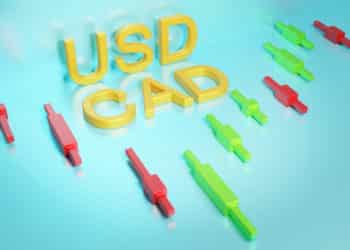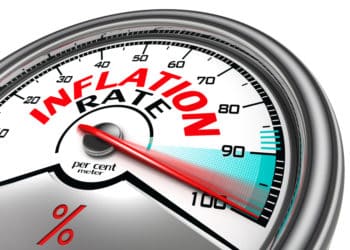AUDUSD or the Aussie is a ‘fan favorite’ among forex traders globally. As a result, it’s frequently in the top 10 of most traded currency pairs. In the 2019 triennial survey by the Bank of International Settlement, this pair accounted for about 7% of all forex turnover.
This market underpins the economies of two highly developed nations – Australia and the United States.
Both countries engage in numerous trade partnerships on a yearly basis, meaning there are plenty of AUDUSD transactions occurring in the markets. About 13% of Australia’s exports are to the United States.
As expected, AUDUSD is a rate-price quote for traders to know how many US dollars are required to exchange one Australian dollar. With the present exchange rate of 0.71, you need $0.71 to purchase one Australian dollar.
Like any currency market, various factors are constantly at play affecting the value of this pair. So, let’s explore what moves the Aussie and why.
Characteristics of the Aussie
The Aussie forms part of the major pairs, currencies paired against the USD. These markets share a noticeable relationship because of the dollar’s influence. You can expect immense liquidity, relatively high volatility, stable price behavior, 24/5 access, and cheap spreads with this market.
Over the last decade or so, the US dollar has been marginally stronger than AUD. There’s generally a bearish bias for this pair in the long term, as we can see in the chart below.

Of course, this doesn’t mean there aren’t plenty of buying opportunities that appear in the short term, considering both economies are equally competitive. Another interesting point about Aussie is its status as a ‘commodity pair’ because of Australia’s heavy exports in several commodities like iron ore, gold, coal, and copper.
Therefore, it means commodity prices have an influence on price movements for this market. Let’s now explore the specific fundamental drivers you should know about AUDUSD.
Commodities
As previously mentioned, a large portion of Australia’s exports is commodities. We believe focusing on gold (XAUUSD) is a better option as it’s a more accessible market than iron ore and coal.
As expected, the Aussie shares a positive correlation because the primary gold price is USD-based. So, when the value of gold and the other commodities Australia produces go up, more transactions occur in AUD, consequently strengthening the Aussie pair.
Conversely, when the commodity markets are in a slump, it’s likely to have downward pressure on Australia’s economy and the AUDUSD pair.
Interest rates
As with any economy, interest rates are influential in monetary policies and tremendously affect the supply and demand of currencies. The central banks for the United States and Australia are the Reserve Bank of Australia (RBA) and the Federal Reserve, respectively.
It’s not just the actual interest rate results that are impactful but sometimes what is anticipated by analysts and economists before each report. Traders compare the interest rates of each respective central bank to work out the differential.
Over the past year, the RBA has maintained a 0.1% interest, while the Fed has kept it at 0.25%. It’s one of the reasons why the US dollar has performed better than AUD overall within the last few years.
A higher interest rate than the previous result suggests a more valuable currency because of the greater foreign investment and an added incentive for citizens to gain better saving rates.
Conversely, if the figure is lower than the last reading, it often makes the currency less in-demand for the opposite reasons. Although central banks rarely make any shifts to the interest rates (despite reports being released around eight times a year), this economic indicator is still closely followed by traders globally.
If any of the central banks were to make any future interest rate changes, a noticeable reaction for AUDUSD in the markets is certain.
Consumer Price Index (CPI)
The CPI is an index showing the growth and decline in consumer prices as a percentage. It’s an indicator for experts to gauge inflation, an impactful element in currency valuations considering the purchasing power of money declines over time.
Put simply, a higher CPI is positive and considered a bullish sign as it means a currency is being used more frequently if citizens are affording higher prices. Conversely, when the CPI reading is lower than previously, this is a negative sign, making the currency in question less valuable.
Like with interest rates, analysts compare the CPI figures of the two countries to find any differences. Data for this indicator is released monthly by the Australian Bureau of Statistics and the US Bureau of Labor Statistics for their respective countries.
Gross Domestic Product (GDP)
The GDP is frequently used when analysts seek a broad overview of economic growth or decline. This indicator (measured as a percentage) accounts for the total value of all goods and services produced in a country within a quarter.
However, as with most countries, preliminary reports are released once in each of the two months before the final quarterly result. These can provide traders with a heads-up of the actual figure released on a chosen day in March, June, September, and December of the year.
Generally, a higher GDP is a bullish signal, while a lower GDP is perceived as a bearish signal. Traders will understandably compare the GDP figures between Australia and the USA to make an informed decision.
For instance, if America’s GDP for a particular month (whether from the preliminary or final report) is lower than Australia’s, there’s a chance AUDUSD would rise for an indefinite period. Of course, the opposite applies.
Final word
Overall, it’d be impossible to cover all the hundreds of variables that can influence AUDUSD at any moment. This article has outlined some of the most significant indicators impacting price movements over several days, weeks, or longer.
Traders need to be on their toes with AUDUSD and closely study the drivers of both currencies individually and holistically.







